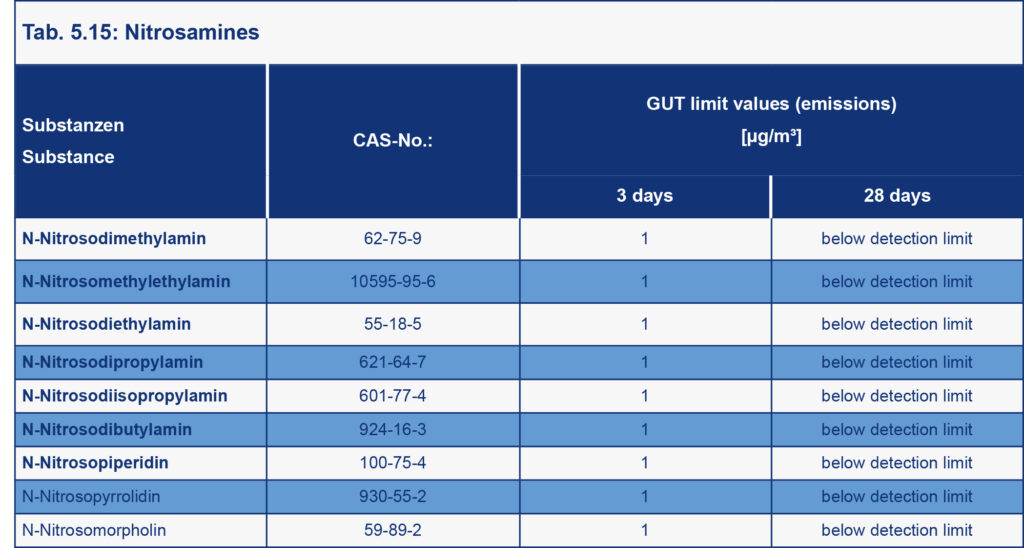Valeurs limites et interdictions d’utilisation
pour des substances individuelles ou des classes de substances
dans le cadre des tests de moquettes
Cette page vous fournit des informations complémentaires sur les valeurs limites et les interdictions d’utilisation de substances spécifiques et de classes de substances dans la fabrication des revêtements de sol textiles.
Sécurité pour le consommateur et protection de l’environnement
Des procédés classiques d’analyse chimique ainsi que des tests modernes rapides sont utilisés pour contrôler les matières premières et le produit textile fini sur la teneur éventuelle d’un vaste éventail de substances nocives et polluantes. Parmi ces substances, on compte, entre autres, les métaux lourds, plastifiants, biocides, pesticides, POP classiques (polluants organiques persistants) ainsi que les substances extrêmement préoccupantes (SVHC) au regard du Règlement REACh.
Les substances ou groupes de substances listés ci-dessous font l’objet d’affectations de valeurs limites ou d’interdictions d’utilisation dans le système GUT.
Ces mesures sont non seulement dédiées à la sécurité des consommateurs, mais aussi à l’évitement d’impacts négatifs sur l’environnement. Les tableaux suivants fournissent des informations sur les différentes classes de polluants et sur les valeurs limites qui leur sont affectées.
Colorants et additifs de teinture (1 sur 7)
INFORMATIONS COMPLÈMENTAIRES :
L’utilisation de colorants classés comme substances allergènes ou cancérigènes est interdite dans le cadre du système GUT.
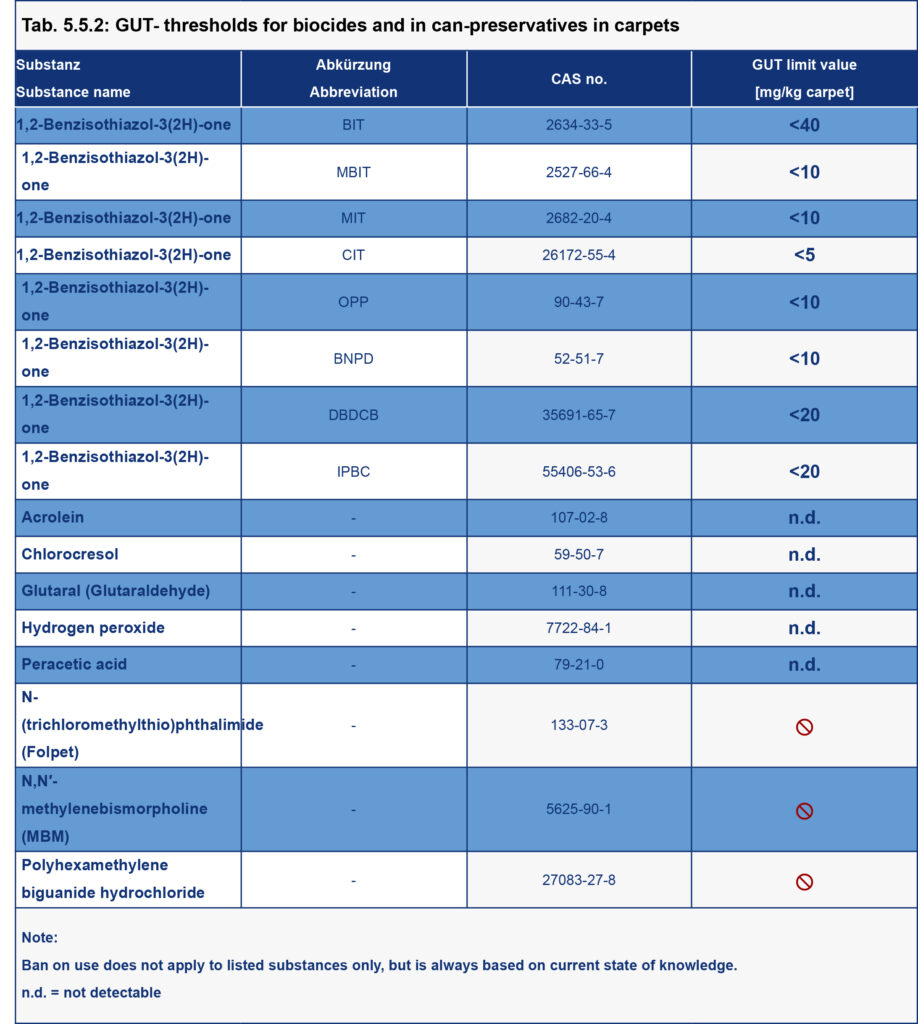
INFORMATIONS COMPLÈMENTAIRES :
Le Colour Index International compte près de 4000 colorants, dont près de la moitié sont des colorants azoïques, qui représentent ainsi de loin le groupe de colorants le plus important. Un bon nombre de ces colorants azoïques sont produits sur la base d’amines cancérigènes, dont certaines sont encore disponibles dans le commerce aujourd’hui. Lorsqu’ils ont été absorbés par l’organisme humain, ces composés azoïques peuvent être redécomposés dans le métabolisme et former ainsi les amines aromatiques, à partir desquelles ils ont été synthétisés. La dégradation des colorants azoïques est possible sous l’action des bactéries intestinales, mais aussi par des enzymes contenues dans le foie.
L’utilisation des colorants azoïques listés est interdite dans le système GUT.
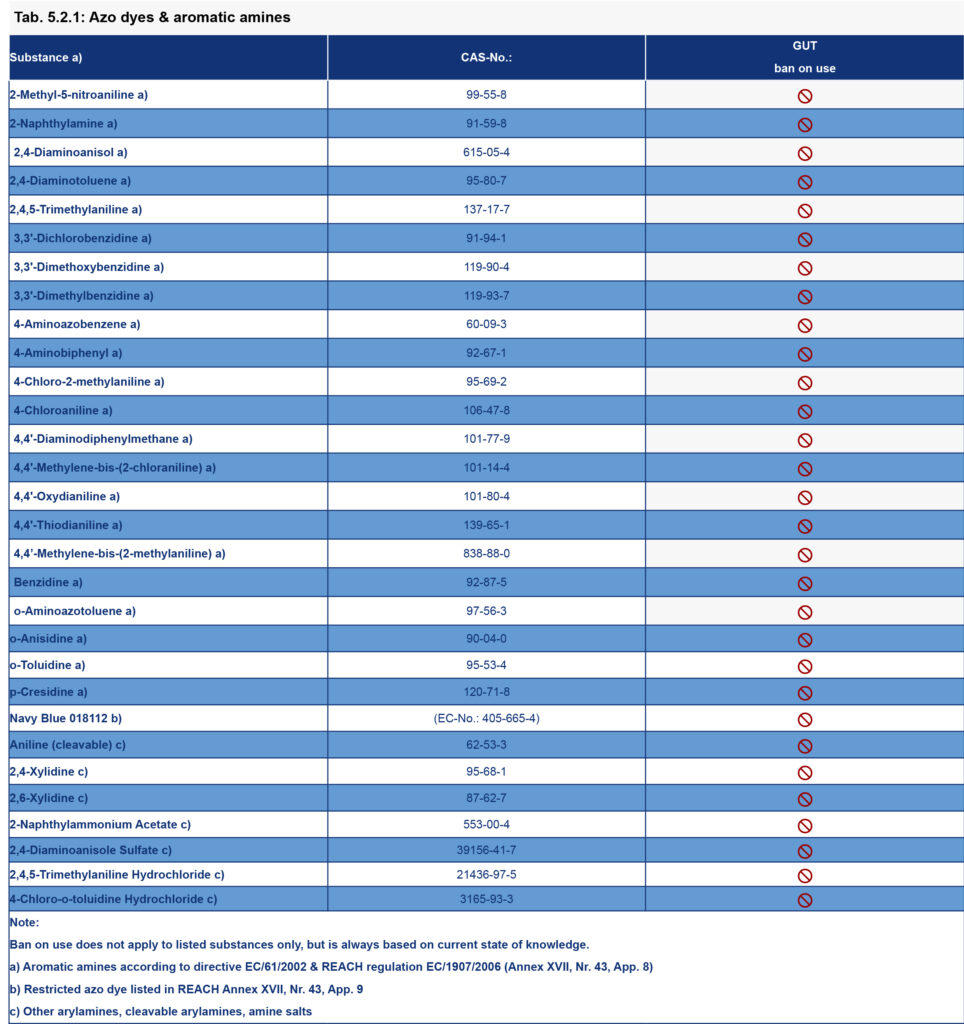
INFORMATIONS COMPLÈMENTAIRES :
Les véhiculeurs de teinture (carrier) sont des solvants organiques utilisés avec des colorants dispersés comme produits auxiliaires dans la teinture de fibres synthétiques (polyester, acétate de cellulose, polyacrylique, polyamide). Ils provoquent une pénétration plus rapide des colorants dans les fibres. La teinture avec des colorants dispersés tient une place particulièrement importante dans le domaine du polyester (polytéréphtalate d’éthylène, PET) qui est la fibre synthétique la plus utilisée pour les vêtements en termes de quantité. Cette teinture est effectuée à l’aide de véhiculeurs à 95 °C ou dans des conditions de haute température (HT) à 130 °C. En principe, les véhiculeurs ne sont pas nécessaires pour la teinture HT, mais ils sont cependant utilisés en faibles quantités comme véhiculeurs d’égalisation pour obtenir une teinture plus uniforme. Les véhiculeurs sont également utilisés pour la teinture des tissus mixtes polyester/coton car la teneur en coton implique une limite de température à 110 – 115 °C.
Lorsque la teinture est achevée, les teneurs résiduelles correspondent à une valeur située entre 5 et 37 g/kg de fibres (0,5 – 3,7 %) en fonction de la substance et du système de teinture. Les teneurs en véhiculeurs peuvent être réduites par divers traitements subséquents, mais une élimination complète n’est guère possible. Si la teinture a été réalisée dans les règles de l’art, la concentration de véhiculeurs est inférieure à 0,2 %, dans le cas contraire les teneurs sur le produit textile peuvent atteindre 2,7 %.
L’utilisation des véhiculeurs de teinture listés est interdite dans le système GUT.

Métaux lourds et plastifiants (2 sur 7)
INFORMATIONS COMPLÈMENTAIRES :
Jouant un rôle important dans l’organisme des végétaux, des animaux et des êtres humains, les métaux lourds sont présents à l’état naturel sous diverses formes. Une carence en métaux lourds essentiels peut même entraîner des atteintes à la santé.
De nombreux métaux lourds comme, entre autres, le plomb ou l’arsenic, peuvent cependant provoquer de sévères intoxications lorsqu’ils sont ingérés en trop grande quantité.
Pour éviter la contamination de l’environnement par certains métaux lourds, diverses valeurs limites ont été définies dans le système GUT. Ces valeurs peuvent se référer à la teneur d’un métal lourd, mais aussi à sa libération sous des conditions spécifiques.
Le tableau suivant fournit un aperçu des valeurs limites actuellement applicables

INFORMATIONS COMPLÈMENTAIRES :
Les plastifiants sont des substances qui sont ajoutées à des matériaux fragiles et cassants pour les rendre mous, souples ou élastiques pour faciliter leur traitement ou pour leur conférer des propriétés fonctionnelles spécifiques. On les retrouve en grandes quantités dans les matières plastiques, les peintures, les produits à peindre ou à enduire, les mastics d’étanchéité, les articles en caoutchouc ainsi que dans les colles.
Les substances plastifiantes jouent également un rôle dans le finissage textile pour améliorer la perception haptique et la douceur. Les plastifiants peuvent se dégager de la matière.
Les plastifiants dans l’air intérieur et la poussière domestique sont essentiellement issus des produits de construction tels que les revêtements de sol, les mains courantes, les joints de portes et de fenêtres s’ils contiennent du PVC dur ou souple, les câbles électriques, les meubles fabriqués avec l’utilisation de colles ou de peintures contenant des phtalates, ainsi que des objets d’aménagement, des garnitures de baignoire et de douche et des rideaux de douche.
Les plastifiants à base de phtalates sont particulièrement préoccupants en raison de leurs effets de perturbation endocrinienne.
L’utilisation des substances listées suivantes est interdite dans le cadre du système GUT.
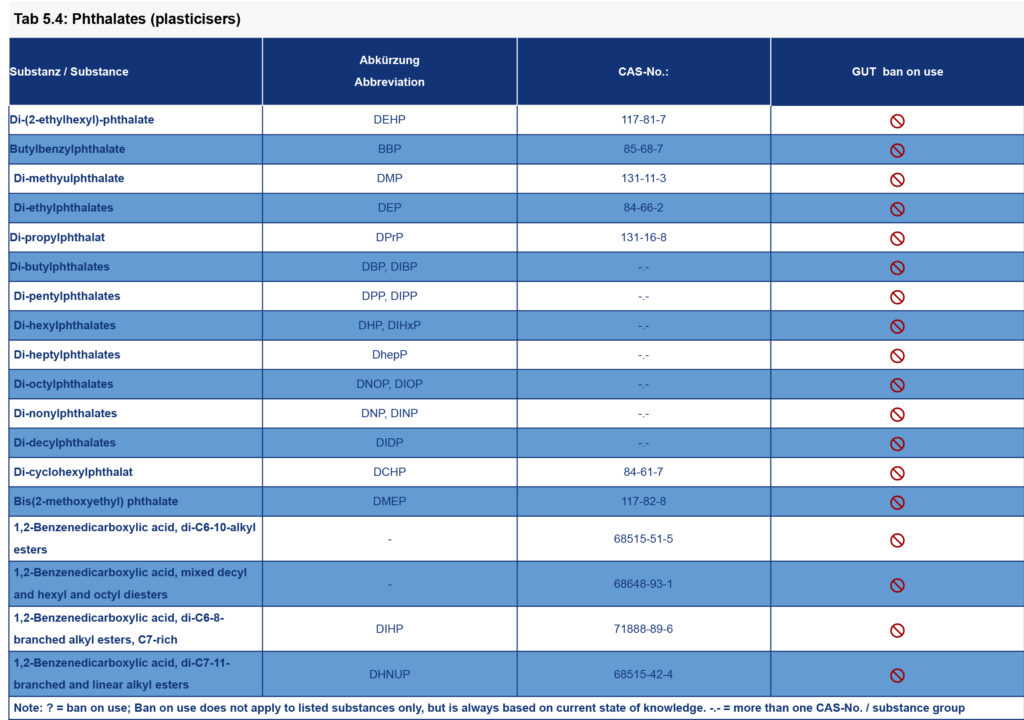
Traitements biocides, agents conservateurs et pesticides (3 sur 7)
INFORMATIONS COMPLÈMENTAIRES :
Appartenant au groupe des pesticides organochlorés, les chlorophénols sont utilisés comme produits de préservation du bois, herbicides, fongicides et pour le blanchiment de la pâte à papier dans la production de papier. Le pentachlorophénol (PCP) est interdit depuis longtemps á cause de sa toxicité.
Présence potentielle dans les locaux intérieurs:
- Surfaces en bois traitées avec un produit de préservation du bois, par ex. poutres, planchers, fenêtres, charpentes
- Textiles en cuir traités et imprégnés, par ex. canapés, chaussures, vêtements en cuir
- Matières naturelles traitées, par ex. laine, fibres de coco
- Peintures, laques
L’utilisation des substances mentionnées suivantes est interdite dans le cadre du système GUT.
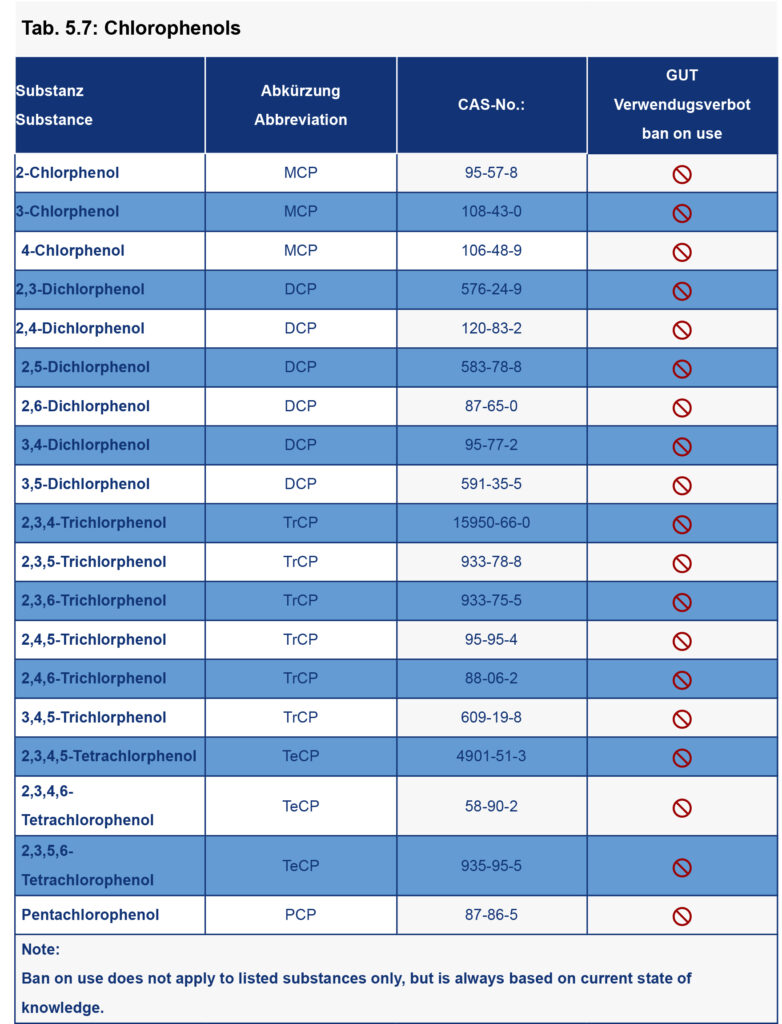
INFORMATIONS COMPLÈMENTAIRES :
Également appelés organostanniques ou organoétains, les composés organiques de l’étain peuvent être utilisés comme biocides dans les produits de préservation du bois, mais aussi comme additifs et catalyseurs. La production mondiale de ces produits avoisinait annuellement les 40 000 tonnes à la fin des années 90.
- 76 % ont été utilisés comme stabilisateurs pour le PVC
- 10 % comme biocides dans les revêtements sous-marins
- 8 % comme fongicides et
- 5 % en tant que catalyseurs dans la production de mousses polyuréthanes et de silicones.
Leur utilisation est largement interdite dans l’Union européenne
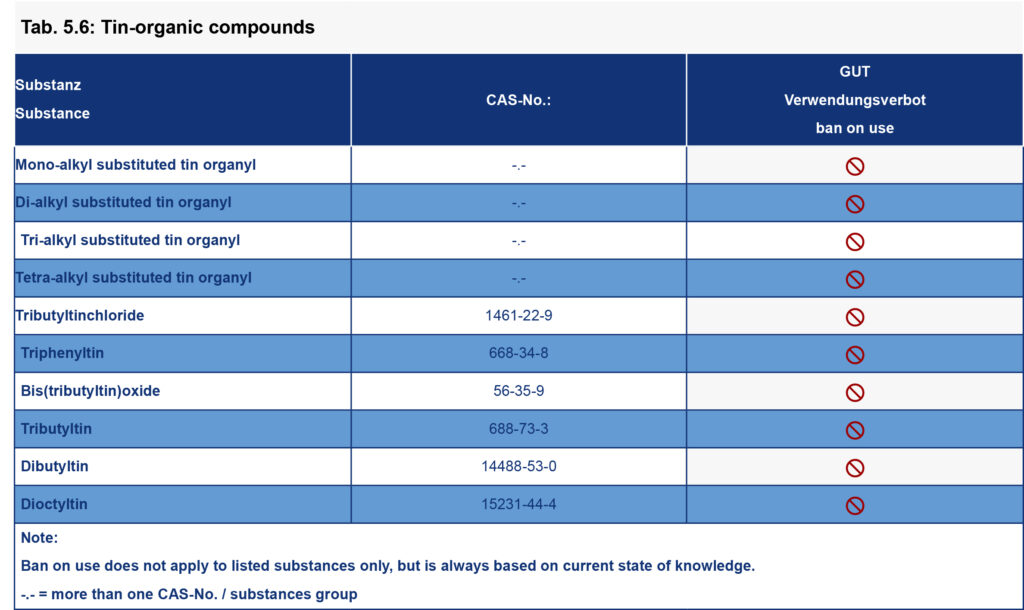
INFORMATIONS COMPLÈMENTAIRES :
Tous les produits phytosanitaires et autres moyens de lutte contre les parasites sont aujourd’hui considérés comme des pesticides. La directive européenne 2009/128/CE contient une définition du terme « pesticide », selon laquelle sont considérés comme pesticides les produits phytosanitaires d’après le règlement (CE) n° 1107/2009 (règlement sur les produits phytopharmaceutiques) ainsi que les produits biocides d’après la directive 98/8/CE concernant la mise sur le marché de produits biocides.
Lorsqu’on parle de « résidus de pesticides » dans le débat public, il s’agit souvent de la contamination des denrées alimentaires par des résidus de pesticides.
L’utilisation des substances mentionnées suivantes est interdite dans le cadre du système GUT
INFORMATIONS COMPLÈMENTAIRES :
La législation européenne considère que les biocides sont des substances chimiques ou des microorganismes destinés à détruire, rebuter, rendre inoffensifs, empêcher l’action ou combattre de toute autre manière les organismes nuisibles par des moyens chimiques ou biologiques.
Le règlementation cible une amélioration du principe de fonctionnement du marché des produits biocides dans l’Union européenne ainsi que l’assurance d’un haut niveau de protection pour l’homme et l’environnement.
Les principes suivants s’appliquent au sein du système GUT pour l’utilisation de biocides :
Les biocides doivent être homologués dans l’Union européenne en tant que
- Produit de type 6 : Protection des produits pendant le stockage
Produit de type 11 : Produits de protection des liquides utilisés dans les systèmes de refroidissement et de fabrication
Produit de type 12 : Produits anti-biofilm - Ces biocides homologués sont soumis à des teneurs GUT et/ou à des valeurs seuils d’élution pour la moquette finale (voir tableau)
- L’utilisation active ou l’ajout de biocides aux revêtements de sol textiles en tant qu’apprêt ou de traitement de surface est interdit
La seule exception est le traitement des tapis en laine avec de la perméthrine (voir traitement de la laine 5.10)
Un traitement biocide, biostatique ou fongicide est en conséquence inadmissible. Si un fabricant propose des revêtements de sol textiles avec et sans traitement biocide, la licence GUT sera uniquement applicable au produit sans traitement biocide.
Remarque :
L’utilisation de biocides, notamment dans la fabrication et le stockage de matières premières, ne peut pas être totalement exclue, car la conservation de matières premières ou la maintenance d’installations de production avec des produits biocides est nécessaire pour éviter une contamination biologique du produit final. La moquette finale peut ainsi contenir des résidus. L’objectif consiste à réduire la teneur résiduelle de ces agents de conservation à un niveau inoffensif pour l’utilisateur. Fort de cette raison, on n’accepte dans ce cas que des biocides qui sont homologués et listés dans le Règlement (UE) n° 528/2012 concernant la mise à disposition sur le marché et l’utilisation des produits biocides.
Les biocides qui sont reconnus ou suspectés d’être cancérigènes, mutagènes ou toxiques pour la reproduction ne sont pas autorisés au sein du système GUT, même si leur utilisation est autorisée dans l’Union européenne.
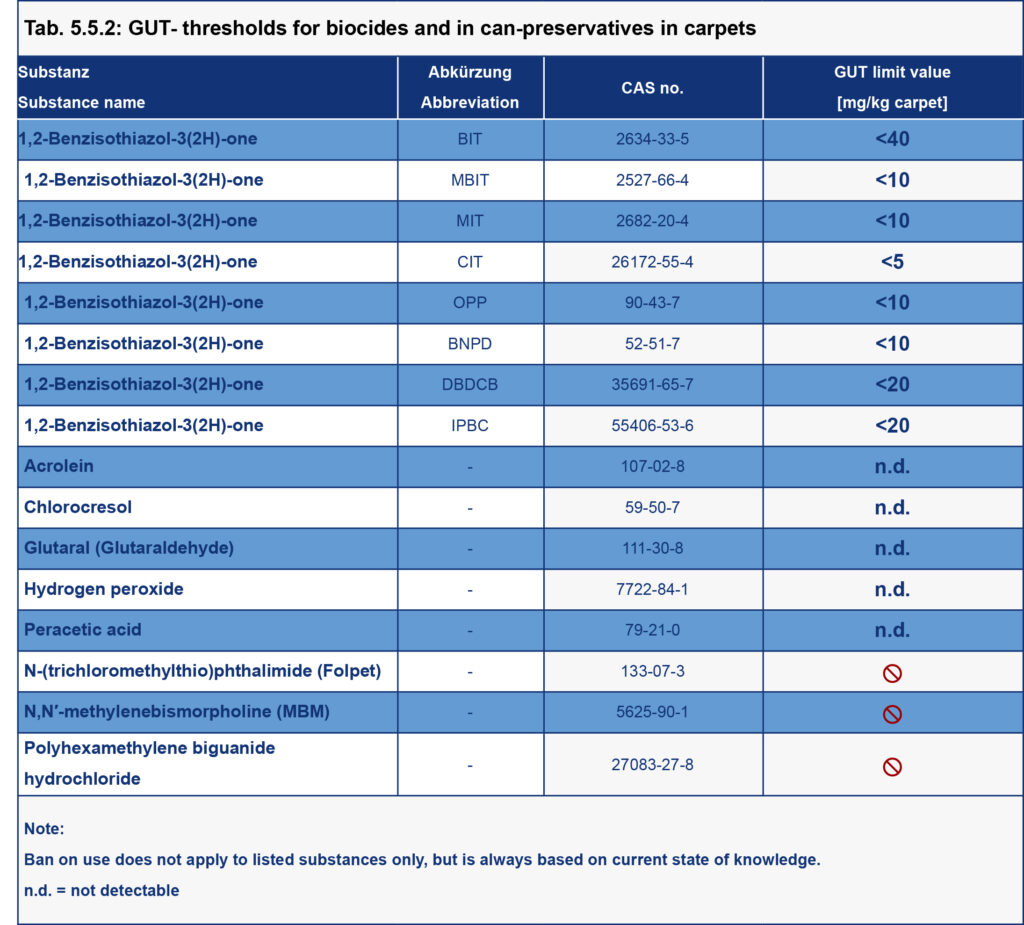
5.5.2.Grenzwerte & Verwendungsverbote_ Substanzen in Teppichböden_biozide
Formaldéhyde et traitements pour la protection de la laine (4 sur 7)
INFORMATIONS COMPLÈMENTAIRES :
Un grand nombre de produits contiennent du formaldéhyde qui peut être libéré et ainsi contaminer l’air intérieur. Malgré les avancées dans l’amélioration des produits au cours des dernières décennies, les matériaux à base de bois, les revêtements de sol, les meubles et certains isolants (par ex. les mousses isolantes d’urée-formaldéhyde (MIUF) sont toujours considérés comme les principales sources. Comparativement, le formaldéhyde est présent en quantités relativement importantes dans la fumée de tabac et même l’utilisation de bougies peur représenter une source de pénétration de formaldéhyde dans l’air intérieur. Le formaldéhyde peut également être présent dans les désinfectants, les cosmétiques et les textiles.
L’utilisation de formaldéhyde et de produits chimiques libérant du formaldéhyde est interdite dans le cadre du système GUT
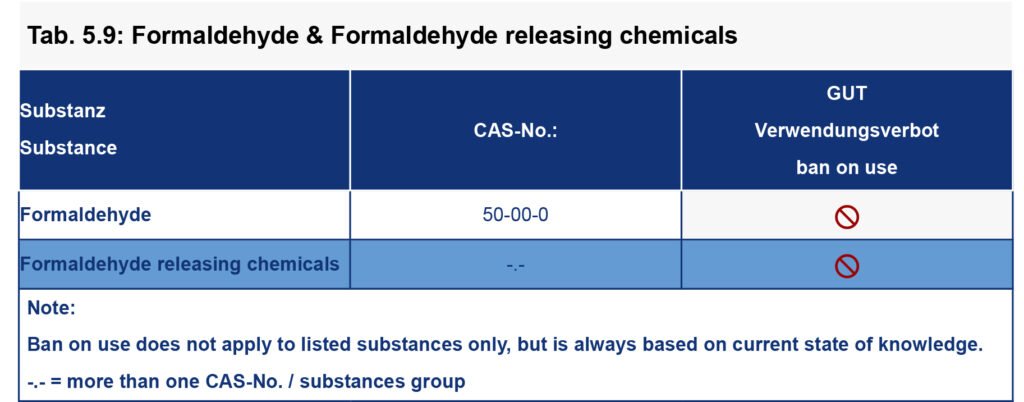
La laine est un matériau constitué de fibres kératiniques, ce qui en fait une source de nourriture pour divers insectes (larves), dont les plus connus sont les larves de mites.
Pour cette raison, on utilise divers produits chimiques pour protéger les fibres de laine.
Dans le cadre du système GUT, seule la substance active perméthrine est autorisée pour le traitement de protection des fibres de laine.
Il existe 3 classes de protection en fonction de la quantité appliquée et, en conséquence, du niveau de protection. La teneur maximale admissible en perméthrine est de 210 mg/kg de laine
- Classe 1 : Aucune protection : = les fibres de laine ne sont pas traitées à la perméthrine
- Classe 2 : Protection normale : = les fibres de laine sont traitées avec un maximum de 150 mg de perméthrine par kg de fibres de laine
- Classe 3 : Protection élevée : = les fibres de laine sont traitées avec un maximum de 210 mg de perméthrine par kg de fibres de laine.
Seuls les procédés de traitement qui permettent d’obtenir un finissage stable des fibres sont autorisés à être utilisés. Les applications par pulvérisation ne sont pas autorisées.
Retardateurs de flammes et HAP (5 sur 7)
INFORMATIONS COMPLÈMENTAIRES :
Bon marché, les huiles de dilution contenant des HAP sont utilisées dans de nombreux produits de consommation. Par ailleurs, on utilise également souvent le noir de carbone pour colorer les matières plastiques et les caoutchoucs en noir.
De nombreux HAP possèdent des propriétés cancérigènes, mutagènes et/ou toxiques pour la reproduction et certains HAP sont en même temps persistants, bioaccumulables et toxiques pour l’homme et pour d’autres organismes.
Les HAP sont des substances qui se forment lors de la combustion incomplète de matériaux organiques telles que le bois, le charbon ou le pétrole. En principe : plus la température du foyer est faible et moins il y a d’oxygène disponible, plus la combustion des matériaux est incomplète et génère proportionnellement plus de HAP. Une grande partie des HAP déjà présents dans l’atmosphère ont été générées par des processus naturels non influençables par l’homme tels que les feux de forêt ou les éruptions volcaniques.
Les émissions de HAP imputables à l’être humain proviennent également essentiellement des processus de combustion : d’installations de combustion domestiques, de processus industriels, de foyers ou de la fumée de tabac.
Les valeurs limites suivantes s’appliquent pour les revêtements de sol textiles dans le cadre du système GUT.
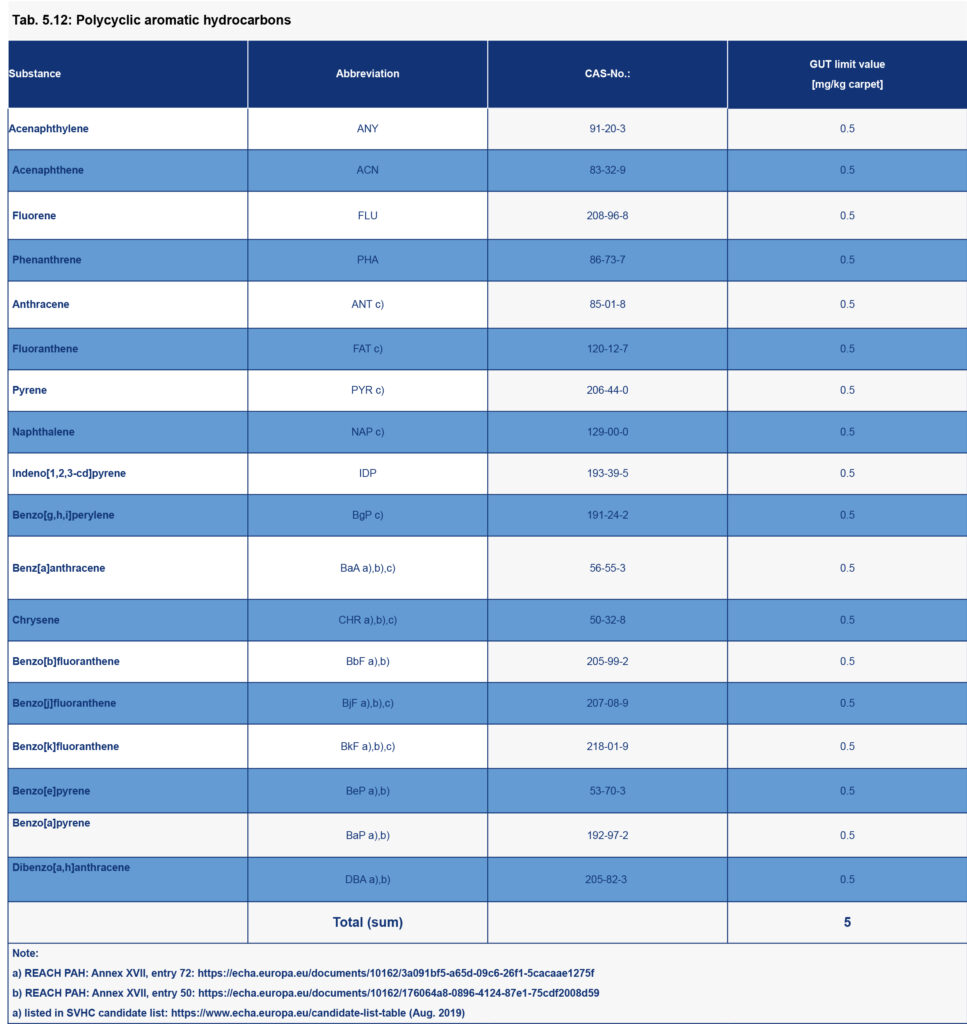
INFORMATIONS COMPLÈMENTAIRES :
Retardateurs de flammes
Les retardateurs de flammes sont des additifs élaborés à partir d’une grande variété de produits chimiques organiques et inorganiques. Leur utilisation est en règle générale adaptée au produit spécifique, à sa composition et à son domaine d’application. On trouve des retardateurs de flammes, entre autres, dans les boîtiers des appareils électriques et électroniques, les circuits imprimés, les câbles, les revêtements des dos de tapis, les textiles spéciaux, les isolants et les mousses techniques. Les retardateurs de flammes organiques sont essentiellement constitués de composés bromés, de composés organophosphorés halogénés ou non halogénés ou de paraffines chlorées.
Les retardateurs de flammes inorganiques les plus courants sont le trihydroxyde d’aluminium (ATH), le dihydroxyde de magnésium ou le trioxyde d’antimoine (en tant que synergiste pour le retardateur de flammes bromé).
Les produits chimiques listés ne sont pas autorisés dans le cadre du système GUT.
73 % des tapis utilisés dans le secteur privé ne nécessitent pas de retardateurs de flamme supplémentaires pour le respect du classement au feu déclaré, l’ATH étant utilisé dans tous les autres cas.
Substances perfluorées (6 sur 7)
INFORMATIONS COMPLÈMENTAIRES :
Le point commun de toutes ces substances est que la liaison carbone-hydrogène typique des composés organiques a été intégralement ou au moins partiellement remplacée par une liaison carbone-fluor. Extrêmement stable, cette liaison confère aux substances une haute résistance chimique et thermique.
L’acide perfluorooctanesulfonique (PFOS) et l’acide perfluorooctanoïque (PFOA) sont des produits chimiques industriels. Les PFOS étaient utilisés jusqu’en 2006, entre autres, en tant que produits de base pour la production de traitements de surface antitaches, oléophobes et hydrofuges pour les tapis, rembourrages et emballages en carton et en papier, ainsi que dans les agents extincteurs.
Fortement restreinte depuis 2006 dans l’Union européenne, l’utilisation des PFOS n’est plus autorisée que dans peu d’applications spéciales. Par contre, les composés à base de PFOA peuvent encore être utilisés jusqu’en 2020. Ils sont notamment utilisés dans l’industrie pour produire des revêtements anti-adhérents pour les poêles et pour rendre les vêtements hydrofuges, oléophobes et antitaches.
Les PFOA, leurs sels et ses composés précurseurs ne pourront plus être fabriqués ni commercialisés à partir de 2020. Les deux substances sont chimiquement très stables, solubles dans l’eau et dans la graisse et pénètrent ainsi facilement dans l’environnement et, en conséquence, dans la chaîne alimentaire.
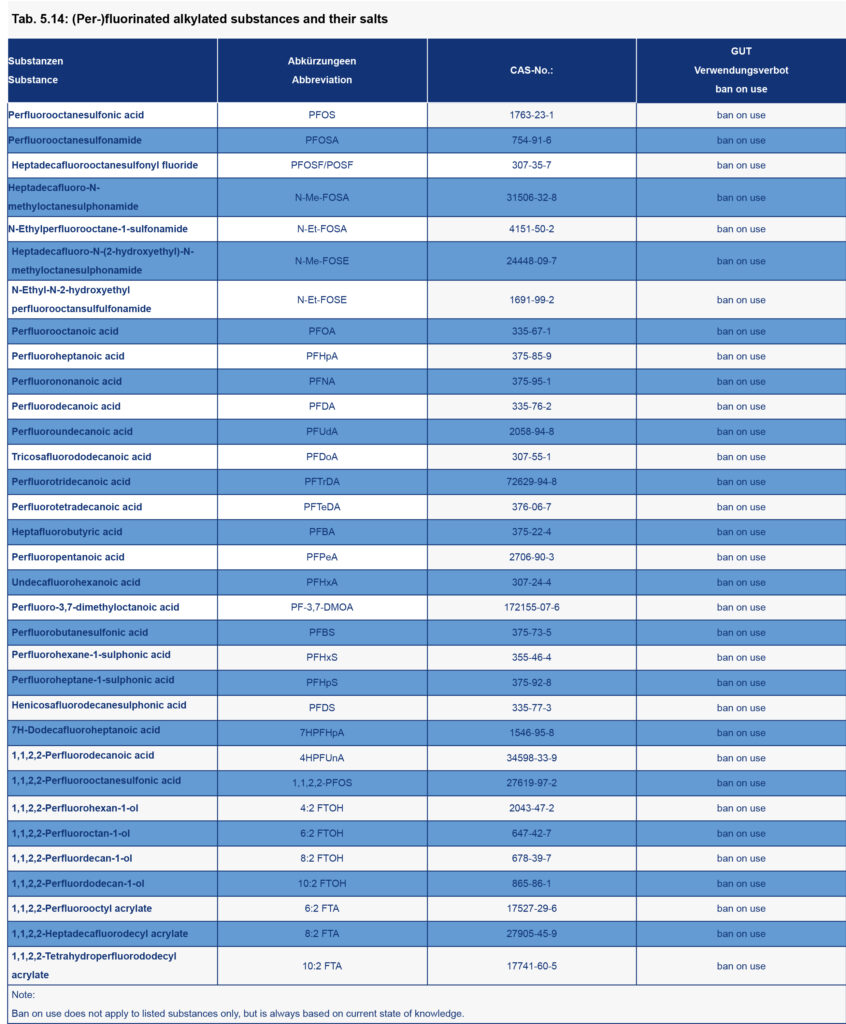
Fibres inorganiques, nitrosamines et autres substances (7 sur 7)
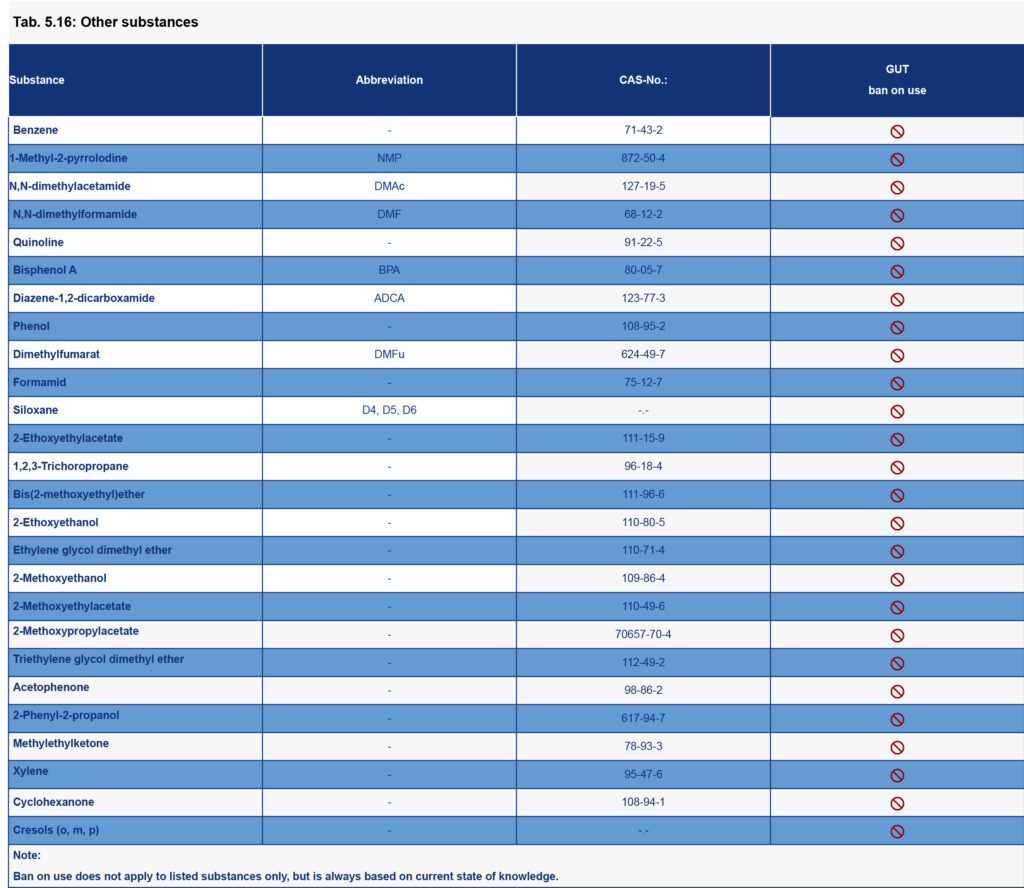
INFORMATIONS COMPLÈMENTAIRES :
L’amiante est un terme générique désignant divers minéraux silicatés cristallisés fibreux d’origine naturelle (fibres inorganiques) qui peuvent être transformés par des traitements spécifiques en fibres de différentes longueurs utilisables pour diverses applications techniques.
Étant donné que ces fibres se rompent facilement en produisant des fragments facilement respirables en raison du rapport longueur/diamètre, les fibres inhalées peuvent provoquer un cancer du poumon. L’utilisation de fibres d’amiante est interdite dans le système GUT.
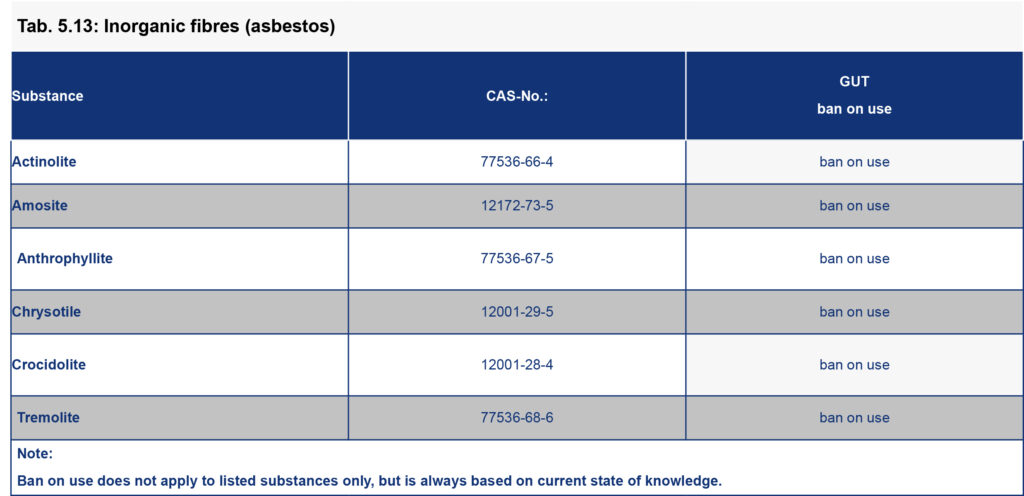
INFORMATIONS COMPLÈMENTAIRES :
La vulcanisation de mousses à base de SBR fait appel à des accélérateurs de vulcanisation qui peuvent générer la formation de nitrosamines sous certaines conditions.
L’utilisation du Zinc diethyldithiocarbamate comme accélérateur de vulcanisation est interdite dans le cadre du système GUT.
Les valeurs limites d’émission suivantes s’appliquent aux nitrosamines
